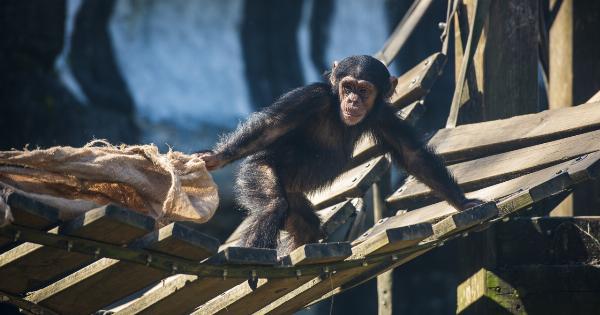Europe’s wildlife is facing a new and unexpected crisis that is threatening the delicate balance of its ecosystems.
The monkey menace, once considered a distant problem confined to Asian and African countries, has now made its way to the heart of Europe. As populations of monkeys grow, they pose a significant threat to local biodiversity, agriculture, and public safety.
The Migration of Monkeys
Historically, monkeys were not native to Europe. However, due to human activities such as the exotic pet trade and the rise in tourism, monkeys have been introduced to various European countries.
The most common species found in Europe are the Barbary macaques, also known as the Barbary apes, which originally belong to the mountainous regions of North Africa.
Irresponsible pet owners often release monkeys into the wild when they become unmanageable.
This, combined with a lack of regulations to control the trade and ownership of exotic animals, has led to the establishment of feral monkey populations in regions such as Gibraltar, the Rock of Gibraltar, and southern Spain.
Impact on Biodiversity
As monkeys establish themselves in new territories, they compete with native wildlife for resources, particularly food and habitat.
Their presence disrupts the ecological balance and threatens the survival of various species, including birds, reptiles, and small mammals.
Monkeys are known to consume a wide range of fruits, nuts, and seeds, which are vital for the dispersal of plant species.
When their populations increase, monkeys exert excessive pressure on local flora, potentially leading to the loss of plant biodiversity. This can have cascading effects on the entire ecosystem, altering the food web and reducing the resilience of native species to environmental changes.
Furthermore, monkeys can outcompete smaller, native primates for resources. The indigenous primates, already struggling due to habitat loss and other human-related factors, face an additional challenge from the invasive monkeys.
This further threatens their existence and pushes them closer to extinction.
Agricultural Damage
Monkeys can wreak havoc on agricultural lands, causing significant economic losses for farmers. They are notorious for raiding crops, damaging fruit orchards, and destroying vegetables.
This places an immense burden on local farmers who rely on their agricultural produce for their livelihoods.
Additionally, monkeys are known carriers of various diseases, including simian herpes B virus. Although rare, this virus can be transmitted to humans, which poses a risk to public health and safety.
The need for increased monitoring and preventive measures becomes crucial when dealing with this potential health hazard.
Conflicts with Humans
While monkeys can evoke feelings of awe and fascination, their presence in urban areas often leads to conflicts with humans. As these populations grow, the overlap between human and monkey habitats increases.
Monkeys have been known to raid houses, steal food, cause damage to property, and even exhibit aggressive behavior towards people.
Residents in affected areas face the challenge of finding a way to coexist with the monkeys while ensuring their own safety.
Balancing the conservation of wildlife with the protection of human interests is a complex challenge that requires careful consideration and appropriate management strategies.
Managing the Monkey Menace
Tackling the monkey menace in Europe requires a comprehensive approach that involves various stakeholders, including governments, conservation organizations, scientists, and local communities.
1. Implementing stricter regulations: Governments need to establish and enforce laws that control the trade, ownership, and release of exotic animals.
This includes banning the private ownership of monkeys and developing licensing systems for zoos and sanctuaries that ensure responsible care and management.
2. Promoting public awareness and education: Educating the public about the ecological, economic, and health impacts of the monkey menace is crucial.
Raising awareness can help in changing attitudes towards keeping exotic animals as pets and foster a sense of responsibility towards wildlife conservation.
3. Enhancing habitat conservation: Protecting and restoring the natural habitats of native species is essential to increase their resilience against invasive monkeys.
Habitat conservation efforts should focus on preserving and creating ecological corridors that allow wildlife to move freely and maintain genetic diversity.
4. Developing effective management strategies: Scientists and conservation organizations need to collaborate to develop innovative and humane methods to manage monkey populations.
This may include non-lethal deterrents, such as visual and acoustic devices, as well as the use of contraceptives that help control population growth.
5.
Establishing wildlife rehabilitation and rescue centers: Establishing dedicated centers that can provide care and rehabilitation for monkeys that are confiscated or voluntarily surrendered can help reduce the pressures on both wild and captive monkey populations.
The Time to Act is Now
The threat posed by the monkey menace in Europe cannot be ignored. It is imperative that governments, organizations, and individuals come together to address this crisis before irreparable damage is done to Europe’s wildlife and ecosystems.
By implementing stricter regulations, raising public awareness, conserving habitats, and developing effective management strategies, Europe can safeguard its biodiversity and prevent further escalation of the monkey menace.
It is time to prioritize the protection of native species and ensure a harmonious coexistence between humans and wildlife.




























